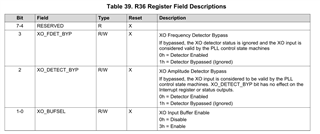Hi all
Would you mind if we ask LMK05028?
On the Table4, it shows XO input Buffer modes.
On the figure 31, there is the despcription in case of DC-coupled LVDS.
It seems that there is internal termination. 
However, on the Table4, in case of 0h, it could not choise internal termination on setting.
So, as the conclusion, in case of DC coupled LVDS, we should use external termination = 100ohm, right?
Kind regards,
Hirotaka Matsumoto
-
Ask a related question
What is a related question?A related question is a question created from another question. When the related question is created, it will be automatically linked to the original question.


